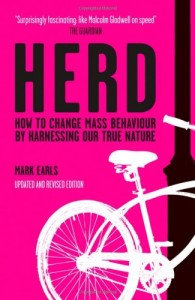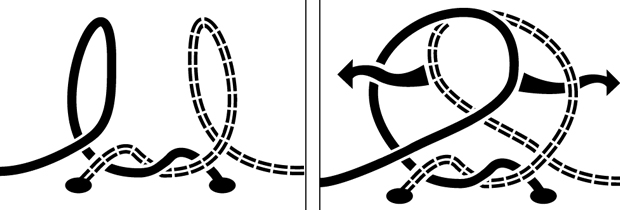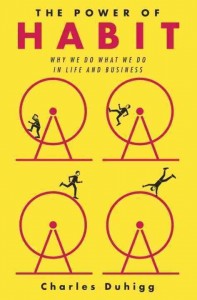How tying your shoelaces differently can help you achieve market domination
Maybe you’ve already found it. A small gem from Ted’s incredibly rich inspiration archives. A short video of Terry Moore explaining that for centuries, we have tied our shoelaces wrong. If not, watch it first and then return to this post.
The bottomline ? Small changes in our behaviour can bring (significant) benefits. And here’s how understanding the underlying dynamics can help you innovate more succesfully.
Most business success stems from innovation. And innovations always require people to change their behaviour (a little). But we hardly ever adapt those changes to reap the benefits. Or it takes ages, as happens with the shoelace tying technique. I doubt whether 1% of the 3,840,534 viewers of the video has changed their behaviour. So if we understand why we resist changing our behaviour we might find a way to influence that and use it to achieve world/market domination. I think of this as ’creating buzzable behaviour’.
To understand why we find it so hard to change our habits you need not look further than the book ‘Power of Habit’. We are all animals of habit. Caught in ‘habit loops’. Trigger, habit, reward. Quick & dirty summary of the book: as the trigger will still occur and you still crave the reward, you need to replace the habit. With which one ? Yours obviously.
I have come across two ways to actually go about doing this. There is a deeper, more difficult path with greater conversion ratios and sustainability and an easier route which will get you some quicker returns.
Disruptive Fun Therapy. If you watch the Bottle Bank video first you’ll understand intuitively what this approach is all about.
You create a fun, disruptive (deviates from normal patterns) experience which teases people to try a different habit. It shakes up your thinking: Hey, changing my habit to a new one is actually not so hard and could be fun ! It works by boosting the actual benefit (get healthier by taking the stairs) through fun additions such as entertainment, storytelling, games. And by lowering the barrier of trying (the cost for the user).
This is a great tool to use when your product or proposition (habit) that you would like to take the place of an existing habit (product) is not too complex, engrained in culture or otherwise ‘big’. Say change your breakfast from bread to a fluid equivalent with cereals. At Buzzer, we created hundreds of ‘BuzzTools’ with similar mechanics that helped consumers discover products and change their consumption patterns.
Customer Transformation. To understand this route, check out the video first.
This is the big one. You need vision, conviction, business cojones to travel this path. Like Google and/or any seriously ambitious startup wanting to become Google. The aim of this is to change your customer. Literally. Make him/her a different person. And the way to do it is to invest heavily in teaching, coaching, supporting your customer to adapt new behaviour. Ask yourself: what were we before we became Googlers ? We were Yellow Pagers. Time Atlassers.
Michael Schrage convincingly describes how Google and other companies focused on changing their target audience’s behaviour through education, not traditonal marketing. Google took us by the hand and transformed us to expect accurate search results in 0.00012 seconds. It helped us discover and adopt a new habit, routine to replace the old one. And take that as the norm. Reaching the holy grail of marketing: loyalty.
A year ago, I designed a customer transformation path for an international financial institution. After great initial enthusiasm and 6 months of creating the first building blocks, the project halted. The company did not have the longer term vision or stamina to pull it trough. We should have gone for the less ambitious road.
 I am currently teaching my youngest daughter Mae to open up bananas the right way. She’s picking it up slowly but held back by all the other people doing it wrong. I estimate that it will take a few generations to get large groups to adapt this. I am thinking about a Fun Therapy technique that will speed this up.
I am currently teaching my youngest daughter Mae to open up bananas the right way. She’s picking it up slowly but held back by all the other people doing it wrong. I estimate that it will take a few generations to get large groups to adapt this. I am thinking about a Fun Therapy technique that will speed this up.
 Most companies convince themselves that traditional advertising will do the trick. “Exercise with our Absolute Abdominal Apparat 20 minutes each week and you will have 200% more energy”. This assumes that the lure (promise of the benefit) is sufficient to adapt a new routine (exercise). But the cost (machine, changing your schedule, finding a place for it, exercising, muscle aches etc.) is not addressed.
Most companies convince themselves that traditional advertising will do the trick. “Exercise with our Absolute Abdominal Apparat 20 minutes each week and you will have 200% more energy”. This assumes that the lure (promise of the benefit) is sufficient to adapt a new routine (exercise). But the cost (machine, changing your schedule, finding a place for it, exercising, muscle aches etc.) is not addressed.
 Of course, people are changing their behaviour all the time without any apparent use of the two methodologies. But then we confuse ‘changing behaviour’ with ‘copying behaviour’. In ‘Herd’ Mark Earls explains how strong our copying tendencies are. But people can only start copying behaviour once others have changed theirs, right ?
Of course, people are changing their behaviour all the time without any apparent use of the two methodologies. But then we confuse ‘changing behaviour’ with ‘copying behaviour’. In ‘Herd’ Mark Earls explains how strong our copying tendencies are. But people can only start copying behaviour once others have changed theirs, right ?
To get the benefits from innovations people need to change their behaviour. This is difficult. To speed up the process you can apply at last two different techniques, suitable for smaller innovations and quicker wins or for more radical innovations and greater gains.
If you know of other approaches or good examples, let me know !











2 Comments Added
Join Discusion